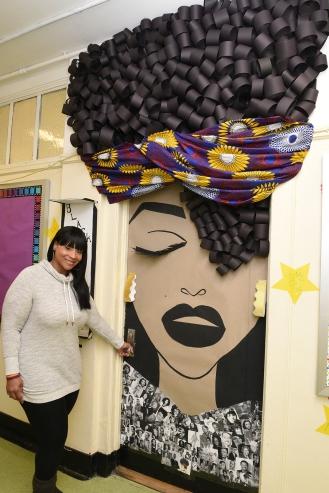
Paraprofessional Hollie Tubbs outside the door she decorated for Black History Month at PS 231 @ PS 54 in Bedford-Stuyvesant.
She set out to inspire her students but ended up inspiring thousands of people across the world.
Paraprofessional Hollie Tubbs chose to decorate her classroom door at PS 231 @ PS 54, a District 75 school in Bedford-Stuyvesant, Brooklyn, with an image of a black woman for this year’s Black History Month. The result went viral on social media, getting hundreds of thousands of likes on Instagram and Facebook. Her door has since been on the cover of the New York Daily News and featured in national media.
“I wanted my students to see themselves in that door,” said Tubbs. “I wanted these children to be able to see themselves in a positive light.”
Tubbs also wanted to celebrate her colleagues. “I wanted to put up a woman because of all the women that work in the classroom,” she said. “Each one of us brings our own special talents to the kids.”
What happened next, she said, was “completely unexpected and overwhelming.”
One of Tubb’s co-workers posted a photo of the door to her Facebook page. The photo was shared by a friend and spread quickly and widely.
“By the evening, it was at 50 or 60 thousand likes,” said Tubbs.
Soon, reporters started calling. Tubb’s Black History Month door has been featured in People magazine, the New York Daily News and on NY1, among other places.
“I’ve had teachers reaching out to me from all over the world,” said Tubbs.
She said she believes her artwork resonated for the same reason she made it: Black women are “rarely portrayed in a positive light” in a society that so often focuses on the achievements of white men.
The door featured a collage of famous African-Americans throughout history, including politicians and celebrities, and Tubbs connected it to weekly lessons and activities highlighting notable African-Americans such as the Tuskegee Airmen. She also made the artwork tactile, with three-dimensional elements her students could touch.
Tubbs says she wanted her students to learn that “no matter who they are or what race they are, no matter their disabilities, they have the ability to make an impression on the world.”